Executive Summary
AI-powered contract data extraction reduces manual review time by up to 50% and eliminates costly errors by automating the identification and capture of critical contract information. Legal teams spend over 30% of their time searching contracts at $300-500 per hour, making traditional processes unsustainable. Modern AI combines NLP, Machine Learning, and Generative AI to process thousands of contracts in seconds with human-like comprehension, transforming weeks-long due diligence into instant insights. Key benefits include consistent accuracy, data-driven portfolio analytics, proactive risk flagging, and applications across legal operations, procurement, and compliance. With poor contract management costing up to 9% of annual revenue, AI extraction delivers significant improvements in efficiency, risk reduction, and strategic decision-making.
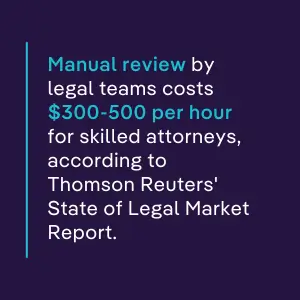
Legal teams spend over 30% of their time searching for information buried in contracts, according to research by World Commerce & Contracting. What if AI could give that time back?
In today’s complex business environment, contracts contain critical data that drives decisions, ensures compliance, and protects your organization. But manually extracting this information is time-consuming, error-prone, and increasingly unsustainable as contract volumes grow.
This guide explores how AI-powered contract data extraction transforms this process, delivering unprecedented efficiency, accuracy, and insights that manual methods simply can’t match.
What Is Contract Data Extraction and Why It Matters
Contract data extraction is the process of identifying and capturing specific information from contracts—everything from basic metadata like parties and dates to complex clauses, obligations, and non-standard terms.
Traditional extraction methods are fundamentally broken:
- Manual review by legal teams costs $300-500 per hour for skilled attorneys, according to Thomson Reuters’ State of Legal Market Report
- Keyword searches miss contextual information and nuanced language
- Template-based solutions fail with non-standard documents or complex clauses
- Version control issues create risk when working with multiple stakeholders
The stakes are high. Missing a renewal date, overlooking a critical obligation, or misinterpreting a clause can result in financial penalties, compliance violations, or damaged business relationships.

The Role of AI in Automating Contract Data Extraction
Modern AI-powered extraction combines several technologies to understand contracts the way humans do—but at machine speed and scale:
Natural Language Processing (NLP) enables systems to understand semantic meaning and context beyond simple keyword matching. This is crucial for legal language where minor variations in wording can have major implications.
Machine Learning (ML) algorithms improve extraction accuracy over time through training on domain-specific contract examples. The more contracts the system processes, the more precise it becomes.
Named Entity Recognition (NER) identifies and classifies key elements within contracts, such as parties, dates, locations, monetary values, and specific clause types.
Optical Character Recognition (OCR) converts scanned documents or PDFs into machine-readable text, essential for digitizing legacy contracts.
Generative AI provides the ability to understand and interpret complex contract language by leveraging large language models that can comprehend context, recognize patterns, and extract meaningful insights from diverse contract formats and structures.
Agentic AI enables autonomous decision-making in the extraction process, allowing systems to prioritize important clauses, identify potential risks or inconsistencies, and take contextually appropriate actions without constant human supervision.
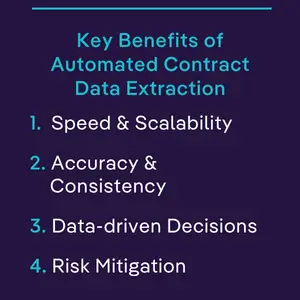
The most advanced solutions combine these technologies with large language models that understand context, handle document variations, and extract information with human-like comprehension but without human limitations.
Key Benefits of Automated Contract Data Extraction
Speed & Scalability
AI systems can analyze contracts in seconds rather than hours, processing thousands of documents across multiple regions without fatigue or delay. This capability transforms projects like due diligence or regulatory compliance reviews from weeks-long endeavors to near-instant insights.
For example, during M&A activities, legal teams can rapidly assess hundreds of contracts to identify risks, obligations, and opportunities that might otherwise remain hidden until problems emerge. Research by Deloitte shows that ineffective due diligence is among the top factors in failed acquisitions.
Accuracy & Consistency
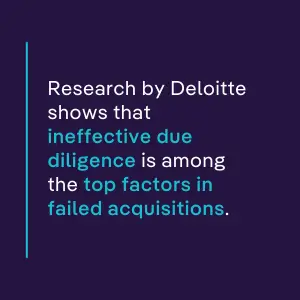
Humans make errors—especially during repetitive tasks or when reviewing lengthy, complex documents. AI maintains consistent accuracy whether reviewing the first contract or the thousandth.
This consistency creates a reliable foundation for decision-making. When your extraction is accurate, downstream processes like obligation management, compliance monitoring, and renewal tracking become more dependable.
Data-Driven Decisions
Structured contract data fuels analytics and reporting that manual processes simply can’t support:
- Compare terms across hundreds of vendor agreements to identify negotiation opportunities
- Analyze language variations to standardize clause libraries
- Track compliance with corporate policies across the contract portfolio
- Identify risk patterns within specific contract types or business units
Research from World Commerce & Contracting shows that poor contract management can cost organizations up to 9% of their annual revenue in value leakage.
This transition from document-centric to data-centric contract management enables strategic insights rather than just tactical reviews.
Risk Mitigation
Proactive identification of problematic clauses, missed obligations, or unfavorable terms reduces organizational risk. AI systems can flag issues like:
- Non-standard indemnification clauses
- Missing data protection provisions
- Unfavorable termination terms
- Auto-renewal periods
- Obligations without clear ownership
This early warning system prevents costly oversights that often go unnoticed until problems arise.
Common Use Cases Across Industries
Legal Operations
Legal teams leverage automated extraction to transform how they manage the contract lifecycle:
- Self-service contract creation with guardrails based on approved terms
- Accelerated review cycles with automatic flagging of problematic clauses
- Obligation tracking with automated assignment and deadline monitoring
- Litigation preparation through rapid evidence gathering across contract repositories
Procurement
For procurement teams, extraction tools provide unprecedented visibility into supplier agreements:
- Compare vendor terms across categories to identify negotiation leverage
- Track performance obligations against SLAs
- Monitor pricing adjustments, volume discounts, and rebate thresholds
- Identify consolidation opportunities across similar suppliers
Financial Services
Banks and financial institutions handle complex regulatory requirements that demand precise contract intelligence:
- Ensure LIBOR transition compliance across thousands of agreements
- Monitor counterparty risks through automated covenant tracking
- Standardize terms across client agreements for consistent enforcement
- Extract financial obligations for accurate revenue recognition and forecasting
Healthcare
- Healthcare organizations balance patient care with complex compliance requirements:
- Monitor BAA agreements for HIPAA compliance
- Track insurance contract terms and reimbursement schedules
- Manage vendor relationships for critical supply chains
- Ensure consistent language in patient consent forms
Why Generic Tools Fail: Pitfalls of Off-the-Shelf Solutions
Many organizations attempt contract extraction with general-purpose OCR tools or basic AI solutions, only to discover these approaches fail to address the unique challenges of legal documents:

Legal language complexity requires specialized training. Generic systems struggle with concepts like “materiality,” “reasonable efforts,” or conditionally triggered obligations.
Jurisdictional variations mean the same concept may be expressed differently across regions. What works for U.S. contracts often fails with UK or EU agreements.
Ambiguity interpretation requires legal expertise embedded in the AI. Understanding whether language is intentionally or unintentionally vague is crucial for proper extraction.
Document structure variations confuse template-based systems. When every counterparty has their own contract format, rigid extraction rules quickly break down.
The result? Poor extraction quality, manual verification requirements that eliminate efficiency gains, and ultimately, abandoned digital transformation initiatives.
How ContractPodAi Extracts Contract Data with AI
ContractPodAi’s approach to contract data extraction fundamentally differs from generic solutions through its purpose-built legal intelligence.
Our Leah Intelligence™ platform:
- Understands legal contexts through specialized training on hundreds of thousands of legal documents across jurisdictions and industries
- Captures hierarchical relationships between clauses, recognizing how provisions relate to each other rather than treating each in isolation
- Integrates with existing systems to ensure extracted data flows seamlessly into CLM workflows, ERP systems, and business intelligence tools
The technology works across the full spectrum of contract documents—from highly structured agreements to complex, custom-negotiated deals with non-standard language.
What to Look for in an AI-Powered Contract Extraction Tool
When evaluating solutions for contract data extraction, consider these critical capabilities:
Domain-Specific Training
The AI should be trained specifically on legal documents, not just general business content. Look for solutions with AI capabilities that can intelligently analyze complex contracts to extract key information that matters to your organization. Ask vendors about their training datasets and legal expertise.
Customization Capabilities
Every organization has unique extraction needs. The best systems allow companies to align AI capabilities to their specific requirements, addressing company and industry-specific regulations and legal nuances not covered by standard frameworks. The solution should allow you to define custom fields and extraction rules without requiring data science expertise.
Security & Compliance
Contract data is sensitive. Ethical guardrails and advanced testing should be fundamental components of professional contract extraction tools, guiding all actions toward compliance and ensuring decisions align with essential standards. Ensure the solution meets enterprise security standards (SOC 2, GDPR, etc.) and provides audit trails for all extraction activities.
Validation Workflows
No AI is perfect. Advanced solutions should deliver clear risk analyses and visual reports, helping your team understand redlines and improve decision-making. The best systems include human-in-the-loop validation processes that efficiently route exceptions for expert review.
Integration Flexibility
Extracted data must flow to where it’s needed. Comprehensive solutions should provide everything you need for contract review and negotiation in one seamless solution, eliminating the need to switch between tools. Look for pre-built connectors to common systems and robust APIs for custom integrations.
Continuous Improvement
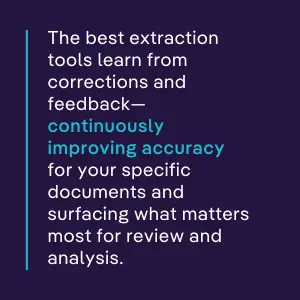
The system should learn from corrections and feedback, becoming more accurate with your specific document types over time. Effective tools should automatically extract key terms, clauses, and data, organizing what matters most for efficient review and analysis.
Scalability
As your contract volume grows, the solution should handle increased load without performance degradation or additional licensing costs. Effective solutions automate repetitive tasks, allowing legal teams to turn contracts around faster and optimize workflows with ease.
Visual Insights
Advanced extraction tools should turn findings into easy-to-grasp charts and visuals, revealing hidden insights that might not be immediately obvious from text data alone. This helps with pattern recognition and decision-making.
Natural Language Interface
Modern contract extraction tools should allow users to ask questions in natural conversational language and get quick, accurate answers by tapping into knowledge base playbooks, saving teams hours of time.
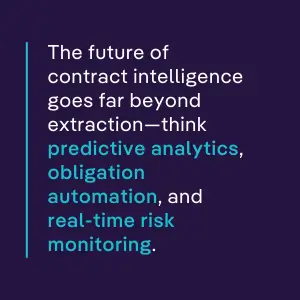
The Future of Contract Intelligence: Beyond Extraction
While extraction forms the foundation, the future of contract intelligence extends far beyond simply pulling data from documents:
- Predictive analytics will identify negotiation opportunities and risks before they become problems, using historical patterns to forecast outcomes
- Obligation automation will connect contract terms directly to workflow systems, automatically triggering actions when obligations become due
- Real-time risk monitoring will continuously assess contract portfolios against changing regulations, business conditions, and corporate policies
- Cross-contract intelligence will identify relationships between agreements that humans would never connect, revealing hidden risks and opportunities
According to research from Gartner cited by Bloomberg Law, AI-based contract analytics solutions can reduce the manual effort needed for contract review by 50%.
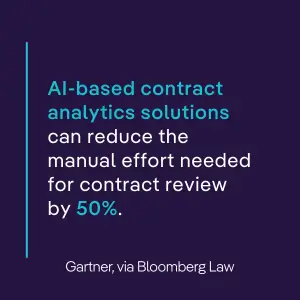
Organizations that establish strong extraction capabilities today are positioning themselves to benefit from these advanced applications as the technology evolves.
Taking the Next Step with Automated Contract Data Extraction
Automating contract data extraction isn’t just about efficiency—it’s about transforming how legal and business teams use contract information to drive decisions and reduce risk.
The most successful implementations follow a measured approach:
- Start with a defined use case (e.g., vendor contract analysis or regulatory compliance)
- Select a solution with legal-specific AI capabilities
- Measure results against clear KPIs (time saved, accuracy improvements, risk reduction)
- Expand to additional contract types and use cases
ContractPodAi’s AI-powered contract data extraction delivers the accuracy, scalability, and intelligence that modern legal teams need to transform contract management from a document-centric process to a strategic, data-driven function.
See how ContractPodAi’s Leah Intelligence™ can transform your approach to contract management. Request a personalized demo today.
AI Contract Data Extraction Q&A
How can I set up an AI system to automatically extract contract data effectively?
Setting up an AI system for contract data extraction requires selecting domain-specific solutions and implementing proper validation workflows. Start with AI tools specifically trained on legal documents rather than generic OCR systems, as legal language requires specialized understanding. Implement a pilot program with a defined use case like vendor analysis or compliance tracking, measuring KPIs including time saved and accuracy improvements. Ensure the system includes human-in-the-loop validation, OCR capabilities for scanned documents, and integration with existing CLM and ERP systems. Key success factors include legal-specific AI training, customization for company-specific rules, enterprise security compliance, and continuous learning from corrections.
What are the best practices for training AI models for accurate contract extraction?
Training AI models for contract extraction requires extensive legal datasets, diverse document types, and continuous feedback loops for high accuracy. Train on hundreds of thousands of legal documents across multiple jurisdictions and industries to handle language variations. Use diverse contract types including structured agreements and custom deals for robust performance. Implement Named Entity Recognition (NER) for parties, dates, and monetary values, plus Natural Language Processing (NLP) for semantic understanding. Establish validation workflows where legal experts review and correct results, feeding feedback into the model for continuous improvement. Focus on understanding hierarchical clause relationships and include jurisdictional variations across regions.
How does AI handle complex language and custom fields in contracts?
AI handles complex contract language through Natural Language Processing, Generative AI, and specialized legal training that understands context and custom terminology. Modern systems use large language models trained on legal documents to comprehend nuanced concepts like conditional obligations and materiality thresholds. For custom fields, leading AI solutions allow organizations to define extraction rules without data science expertise, adapting to company-specific terminology and clause structures. Generative AI provides contextual understanding of diverse formats, while Agentic AI enables autonomous decision-making to prioritize clauses and identify inconsistencies. Advanced solutions capture semantic relationships between provisions rather than treating each element independently.
What tools or software should I use to automate my contract data extraction process?
Choose AI-powered tools with legal-specific training, customization capabilities, and enterprise security rather than generic OCR solutions. Look for platforms combining NLP, Machine Learning, Named Entity Recognition, and Generative AI trained specifically on legal documents. Essential features include domain-specific training, customization for company rules, OCR for scanned documents, human-in-the-loop validation, and integrations with CLM and ERP systems. Avoid generic tools that struggle with legal complexity and jurisdictional variations. Professional solutions like ContractPodAi’s Leah Intelligence™ offer specialized legal AI with enterprise security standards and scalability.
How can I ensure the quality and accuracy of AI-extracted contract information?
Ensuring AI extraction accuracy requires validation workflows, continuous learning systems, and proper quality control measures. Establish human-in-the-loop processes where legal experts review results and provide corrections for system improvement. Implement confidence scoring that flags uncertain extractions for manual review and create approval workflows for exceptions. Use validation datasets to test accuracy across contract types and maintain audit trails for all activities. Set up regular retraining cycles using feedback to improve performance, and choose AI solutions with legal-specific training rather than generic tools for better accuracy with complex language and jurisdictional variations.


